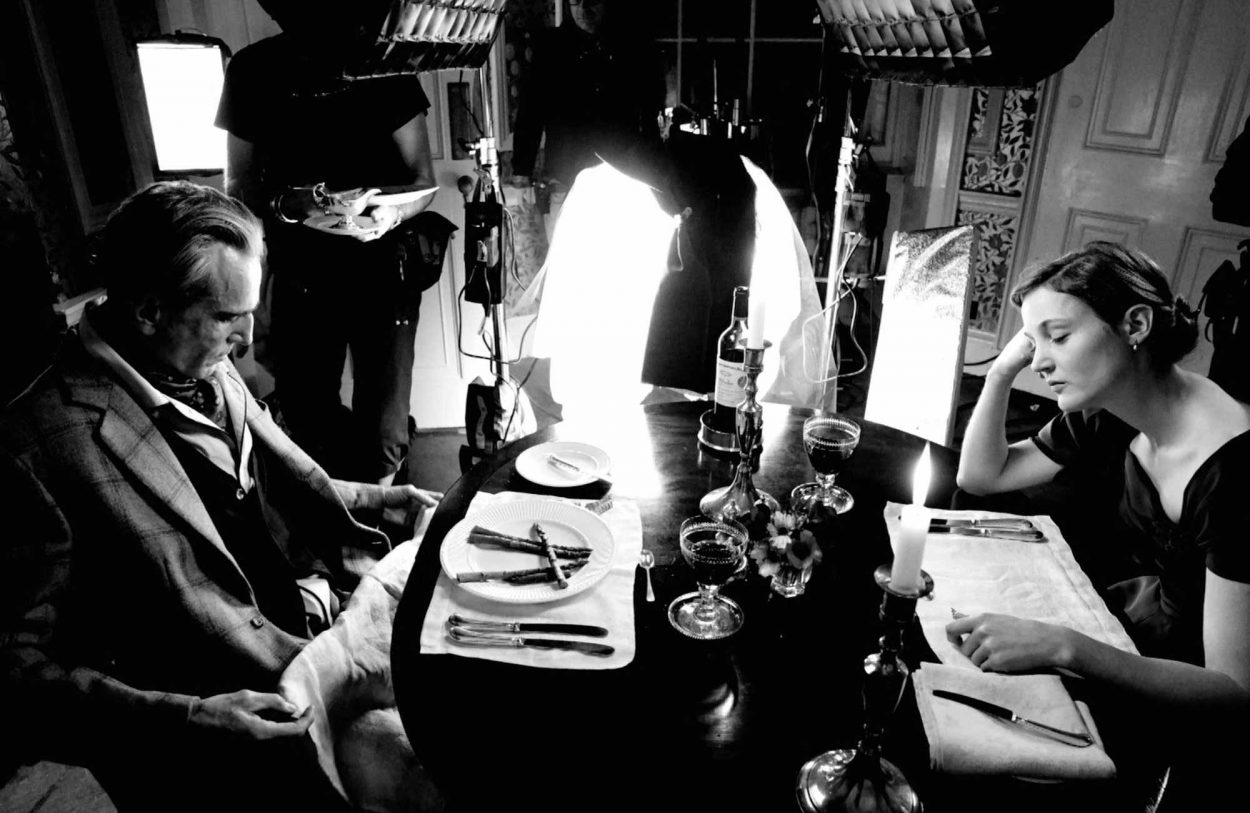The Silent Partner begins with the Eaton Centre mall, which stands beneath a yawning slatescape of Toronto’s flat winter sky hanging low and heavy with the greywater murk of a cataract. A massive, glass-walled enclosure, the mall is marbled with businesses and pumped tight with Christmas shoppers, Christmas carolers, Christmas bands, Christmas shops, Christmas trees and lights and décor and music, all crisscrossed with tinseled escalators and elevators that float shoppers and businesspeople alike from one level to another, their faces flat and focused in pursuit of that which brought them here.
From the mall’s lone financial institution, The First Bank of Toronto, nebbish bank teller Miles Cullen (a hypnotically restrained and muted Elliot Gould) watches it all with the stuffy, officious numbness of a man counting down the seconds of his life like so many dollar bills, every day, counting down just to do it all over again the same way tomorrow. And the next day. And the next. A steady, bubbling accretion of the same daily business deposits made by the same Mr. Fogelmans, Mrs. Skinners, and Mr. Donaldsons. The same weekly rejections of his stilted and stultifying romantic overtures by his alluring coworker, Julie (Susannah York). The same teeming schools of mall shoppers passing daily outside the bank’s glass walls. This glass cage of a mall is a self-contained ecosystem where time is both forever at a standstill and leaking away at an alarming, life-draining rate, all while Miles bobs in place, inactive, watching and silent as it all drains by.
Later, at the film’s halfway point – after the psychopathic Santa, the heist, the double-cross, the missing $48,000, and the Christmas Eve game of cat-and-mouse through Toronto’s streets and subways that climaxes with a setup and an arrest – Miles sits in his apartment, watching his beloved tropical fish swim and dart within the massive glass enclosure of their aquarium. The aquarium is cabled with fake seaweed and pumped tight with strange and rare fish that float from one corner to another, others bobbing in place, their faces flat and focused in pursuit of food flakes and stimuli within this Miles-maintained ecosystem where time is forever at a standstill. Next to Miles sits Elaine (the staggeringly charming Celine Lomez), his father’s nurse, and together they watch as the teeming schools of fish glide inside the aquarium’s glass walls.
“You think they like being kept in a glass cage?” she taunts in her thick French accent.
“I don’t think they think about it,” Miles whispers.
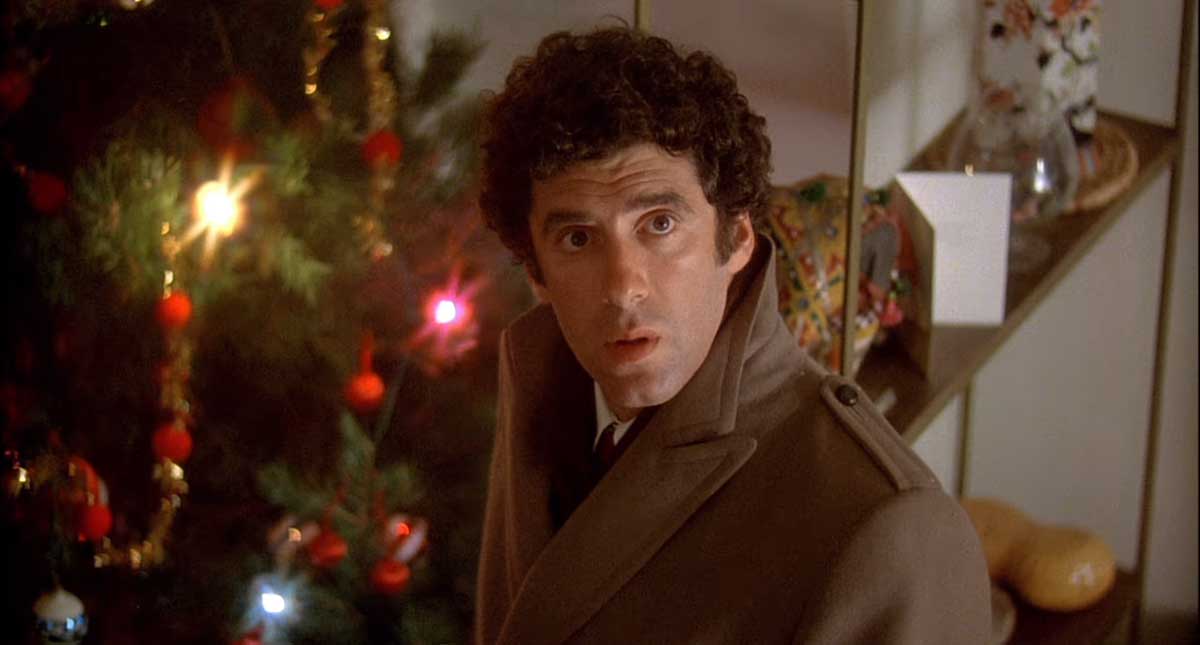
“[Christmas] tends to be a touchstone for me,” writer/director Shane Black once mused when asked why the holiday has informed so much of his work, with the yuletide season’s tangled tendrils of blinking red and green lights twisting its way through so many of his unconventional holiday actioners (such as Kiss Kiss, Bang Bang, the L.A.-set Christmas neo-noir that kicked off the New Beverly’s December 2019 holiday programming). “Christmas represents a little stutter in the march of days, a hush when we have a chance to assess and retrospect our lives…”
More than anything else, it’s that “little stutter in the march of days” that coalesces like windowfrost as the crux of so many Christmas films, unconventional or otherwise: It’s a time in which the routine patterns that hem in our lives become disrupted, and the natural order of things shift – thanks to vacations, family visits, enough time off from work to take stock of our lives, too much eggnog, a significant other’s stoned confession of daydreamed infidelity, guardian angels showing us a universe in which we never existed, vaguely European terrorists holding the Christmas party hostage to stage a secret heist, etc. etc. etc. – and characters have the briefest of snowflit and light-twinkled opportunities to make a change within the cage of their worlds, their wintry aquariums, and break free.
And it’s this kind of cinematic catharsis moviegoers can experience all December at the New Beverly Cinema – from the thief-turned-redeemed-P.I. in Black’s Kiss Kiss, Bang Bang to the women contemplating the consequences of a love affair with one another in Carol to a New York cop trying to salvage his marriage during a Christmas Eve party in Die Hard to a young woman considering an abortion in Black Christmas all the way back to the “Bloody Christmas” LAPD beatings in 1951 that catalyzes so much of the plot and characters of Curtis Hanson’s masterful thriller, L.A. Confidential. And while Black is certainly the king of unconventional Christmas action-noirs (see also: Lethal Weapon, The Last Boy Scout, and The Long Kiss Goodnight), it’s Hanson who helped craft the two greatest, most perfect Christmas crime thrillers ever made.
One of those films, most people know: L.A. Confidential, the aforementioned 1997 Academy Award-winning critical smash. The other, though, remains in the shadows, a cunning and quiet companion to Confidential, little-seen, though no less shattering, brutal, or excellent. The Silent Partner.
“…along with half a dozen other lonely moviegoers, I was witness to a small miracle: To a thriller that was not only intelligently and well-acted and very scary, but also had the most audaciously clockwork plot I’ve seen in a long time…”
“…I won’t describe any more of the plot, which unfolds with a clockwork precision…”
It’s fitting that in his effusive, effulgent review of the 1978 thriller The Silent Partner, Roger Ebert twice referred to the film as a piece of clockwork – the Hanson-penned, Darryl Duke-directed Hitchcockian startler (adapted from Anders Bodelsen’s Danish novel, Think of a Number) unfolds with a tight, terrifying precision, each successive scene revealing something both shocking yet somehow inevitable, each new shock spiraling outward and generating another with an almost mathematical rigor. A miracle of a film in that it is comprised of nothing but surprises (truly, every sequence is an unpredictable left turn from its precursor in a way that feels earned, astonishing, and inexorable), The Silent Partner indeed operates like an expertly designed timepiece, made of ever-turning and inescapable genre gears – the heist film, the cat-and-mouse chase film, the caper film, the romance, grindhouse pulp, Canuxploitation, and (of course) the Christmas film – whose teeth interlock with one another in a horrifying and darkly-funny rigor, all working in inflexible concert with one another to push each desperate second, minute, and hour forward for characters whose most recent Christmas has left them increasingly aware that their time in the mallquarium of life is running out.
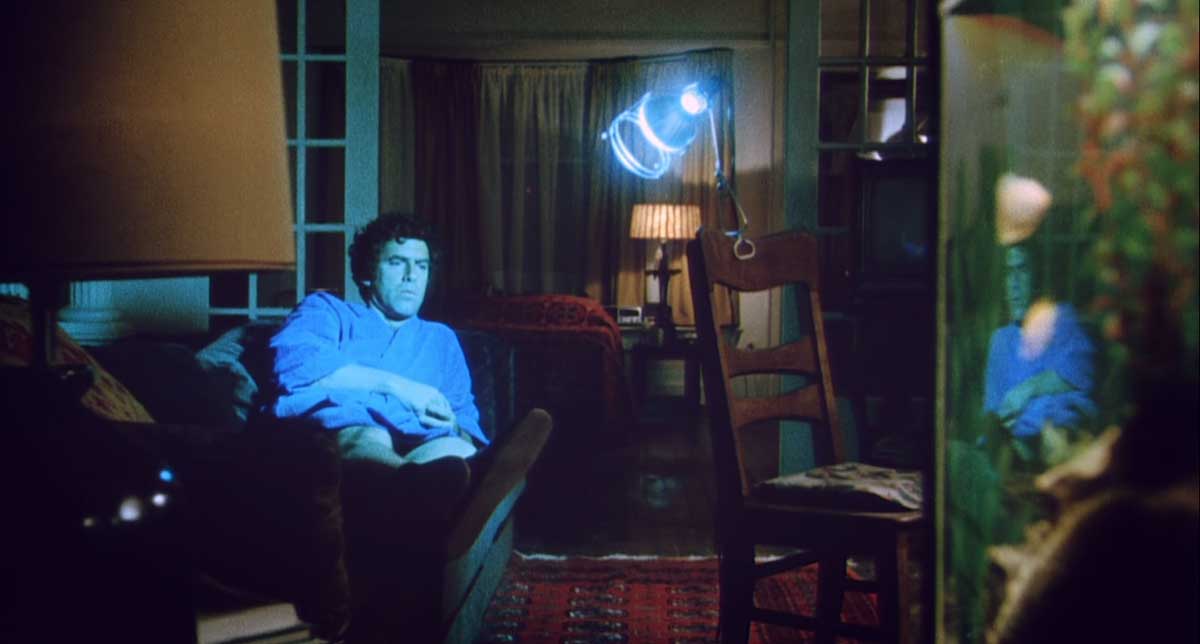
Gould’s Miles Cullen is trapped – by life, by work, by time. As yet another Christmas blows through his lonely life, the film frequently frames him as a man caught and contained: Standing behind the bars of The First Bank of Toronto’s vault. Held within the glass walls of the Eaton Centre mall. Stuck between the youth of his past and the eventual old age and death that time holds for him (a theme made brutally explicit during a scene in which Miles is literally stuck between and childhood and death – sitting morosely between a group of grade-school carolers and his silent, senile father in a retirement home). Miles is a man so rut-stuck in life that even his reflection is imprisoned – in the lone sanctuary his apartment, staring at his fish, his translucent face is frequently framed within the glass case of the aquarium, as trapped within that fishcase as his body is within the mall’s bank.
That is, until Santa Claus comes to town.
While Miles’ fish may not think of being in a cage any more than his coworkers or mallgoers do, Gould evinces a man who clearly, quietly, thinks of nothing but. And when he finds a discarded note from an aborted bank robbery attempt, a note whose distinctive handwriting matches a sign held by a nearby mall Santa that Miles finds a little too attentive of the bank’s daily deposits, he crafts a desperate Christmas gift for himself – pocket a local businessman’s $40,000 deposit the same day this malevolent Santa finally screws up the nerve to stick up the bank for that very same deposit. It’s a plan that could go nightmarishly wrong at any step of the way – but the unexpected nightmare for Miles is that it goes completely right.
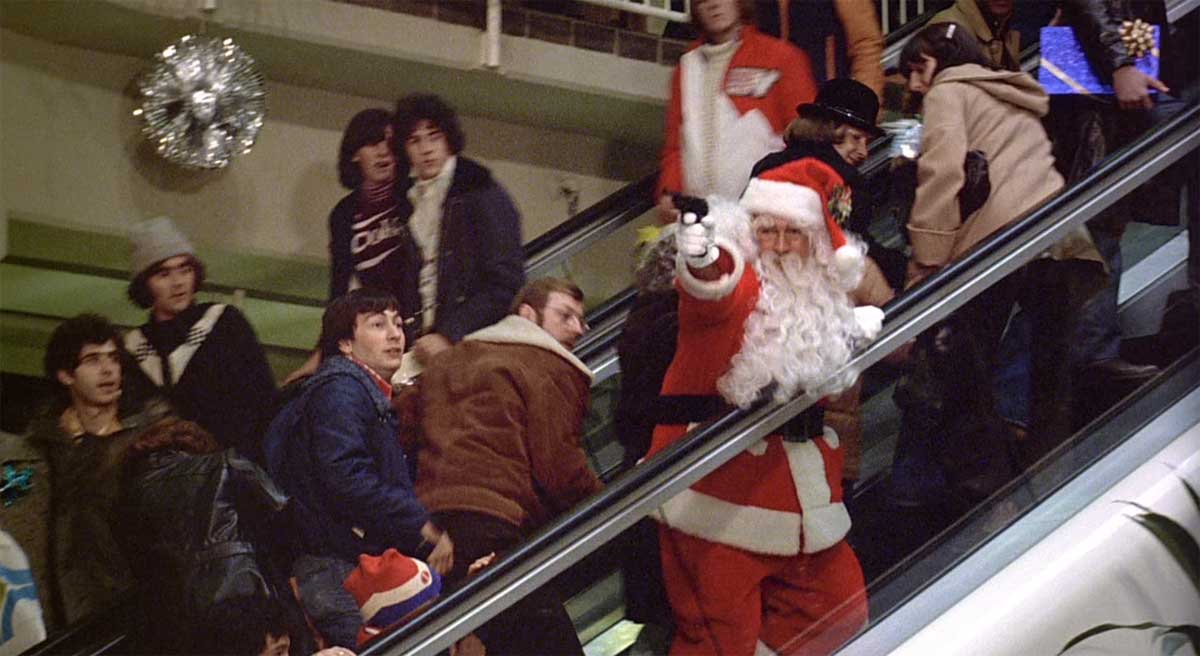
The Silent Partner is nearly impossible to write about with ruining its nearly bottomless Santa’s sack of shocks and surprises, but suffice it to say, Miles is not the only character in the film driven to a make a Christmastime change in his life – utterly amoral sociopath Harry Reikle (a profoundly disturbing Christopher Plummer), disguised as Santa Claus himself, has been staking out The First Bank of Toronto for weeks, and has been counting on the $48,000 deposit of local businessman Mr. Donaldson to provide a life-changing stocking-stuffer for himself. And when he pieces together that he unknowingly had “a silent partner” in the heist in the form of the unassuming bank teller with wide eyes and a storm of curly black hair, and that’s why he only fled the bank with paltry dollars instead of thousands, he makes it his mission to get the money back from Miles with the cold, murderous glee of a natural-born sadist (thus attaching The Silent Partner to the subgenre sleigh of Scary Santa Movie, which is pulled by such titles as Christmas Evil, Don’t Open till Christmas, Silent Night, Deadly Night, and Silent Night, Deadly Night Part 2 – all of which are screening at the Bev this December).
Again, to write about The Silent Partner with deeper specificity is to risk undoing the concussive jolts and jarring plot-kinks that erupt from nearly every scene. That said, it’s fair to reveal that Miles’ newfound life change – the confidence, swagger, and hope that stealing $48,000 from both his bank and a thief has electrified him with – has sapped those very things from Reikle’s world, and what follows is a terrifying game of brinksmanship in which both men underestimate their opponent wile grappling for the flakes of cash and purpose they need to survive. Reikle is consistently shocked by Miles’ ingenuity, his chess-trained ability outmaneuver Reikle’s blunt and bloodthirsty force; Miles is repeatedly hamstrung by his inability to comprehend the depth of Reikle’s sickening inhumanity, his refusal to see that Reikle is capable of literally anything in his pursuit of the $48,000 (there are moments in which the film gearshifts from Hitchcockian terror to full-on horror that will leave you moaning in dismay). Reikle becomes the walking, talking embodiment of inescapable consequences, a malignant growth that haunts Miles’ life (note how only the glowing red “R” from the neon “REAL ESTATE” sign outside of Miles’ living room window is visible from his apartment – “R” for Reikle, as if the man’s lifeforce literally burns into Miles’ world).
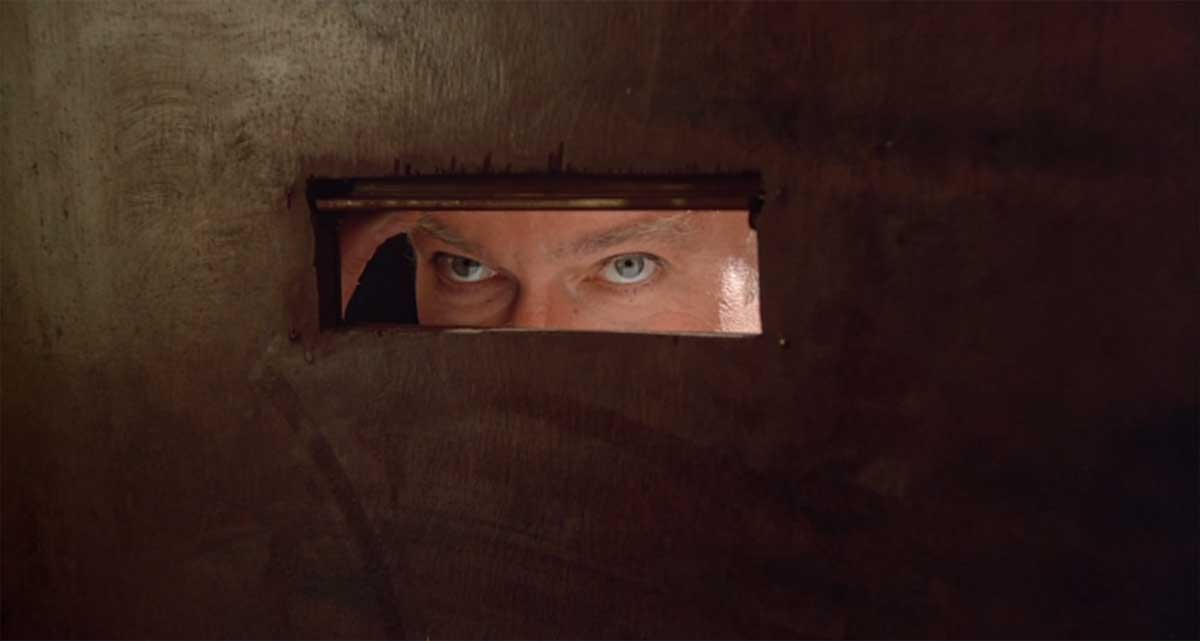
Nothing can prepare a viewer for the stunning double, triple, and quadruple-crosses that litter the film, the surprise-reversals, the sudden jump-scares (particularly effective: Reikle flipping open Miles’ mail slot, revealing only his eyes, and calmly intoning his plans to torture and kill Miles for the money); further, (light spoilers here), the film features enough twisty-turny plotting to generate two amazing movies, let alone The Silent Partner’s tight 106 minutes. Indeed, the film’s early plot – in which Miles suspects Reikle’s heist, steals the money himself, and the two men wage psychological warfare across Toronto in a living chess match that concludes with Miles framing Reikle for a crime he didn’t commit and putting the sociopath behind bars – takes place all within the first 45 minutes! What for most films would be the entire story is essentially The Silent Partner’s opening act, and the hour that follows is likely the most surprising you’ll see at the New Beverly Cinema all year (let alone this Christmas) – and it won’t be spoiled here.
So, in the “little stutter in the march of days” that is the holiday season, take a chance to steal this strange, seductive, and shocking genre-blurring gem. Its pleasures are many (the most un-Gould-like performance of Gould’s career; the less-said-about-them-the-better turns by Plummer and Lomez; the genuinely refreshing sensation of watching an adult thriller that manages to astonish and evade predictability), its depths are terrifying, and its vault contains more secrets than one can imagine. A heist film more plot-twisted than Die Hard, a Canadian horror film more disturbing than Black Christmas, a thriller more soul-blackened than L.A. Confidential, The Silent Partner is the quiet companion to the other unconventional Christmas classics, lurking and lurid, in the frostbitten shadows. See it on Christmas Eve – your aquarium will never, ever be the same.

